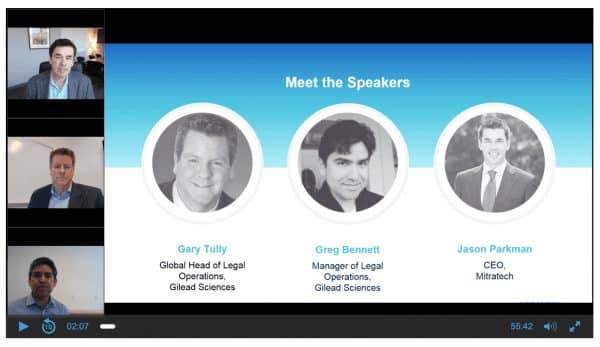Growing a Legal Tech Ecosystem: Gilead Sciences
In building a legal tech stack to support a global legal ecosystem, Legal Ops leaders and CTOs/CIOs shouldn’t be cowed by the challenge. As Gilead Sciences explains, it just takes a clear vision, good planning, and the right people.
Gilead Sciences is a U.S. biotech company with global reach that researches, develops and commercializes drugs, and is a member of both the NASDAQ Biotechnology Index and the S&P 500. As you’d imagine, updating their legal tech stack to meet the needs of an enterprise like that was no small endeavor.
In a new webinar, Gary Tully, Global Head Of Legal Operations, and Greg Bennett, Manager of Legal Operations at Gilead Sciences, were interviewed by Mitratech CEO Jason Parkman about just such a project. Both spoke in depth about how building an updated, efficient and seamlessly integrated technology stack was vital to the success of their Legal Operations. How they did it supplies great guidance for other Legal Ops leaders.
Setting priorities was a first step
At Gilead Sciences, exploring the transition to legal tech solutions started with sound planning. One early and pivotal part of their process? Deciding exactly which tools should be first in line to either be updated or added to their legal tech stack.
“Since we’re responsible for quite a bit, we can’t do all the technology all at once,” Gary Tully explains. “So we’re taking our time and prioritizing through the legal leadership team, getting an idea of what we think is important for the global legal team, and looking at technologies to either update or swap out completely.”
Teaming the right tech with the right people
Having the right team in place to lead a legal tech transition is as important as the software and hardware, Gary points out. “Our priorities are modernizing the legal technologies at Gilead; obviously, getting the right people into the organization is key.” When recruiting Greg Bennett to Gilead, he was looking for individuals with a willingness to push that modernization forward.
A shift in attitudes toward legal tech is underway, they agreed. As Jason added, “It used to be sort of fashionable to call attorneys laggards when it came to technology, but I actually don’t think that’s the case anymore…the expectation is that technology will solve problems and create efficiencies, and they’re expecting there to be technology solutions for things that used to be people- or (manual) process-oriented.”
 The human factor is central to day-to-day operations, too, even after transitioning to the right technology. “When I was hired, I was the only Legal Operations person in the department,” Gary recalls, and one of his early tasks was to address problems in paying outside counsel. “Apparently, the invoices would get stuck in the process,” he says.
The human factor is central to day-to-day operations, too, even after transitioning to the right technology. “When I was hired, I was the only Legal Operations person in the department,” Gary recalls, and one of his early tasks was to address problems in paying outside counsel. “Apparently, the invoices would get stuck in the process,” he says.
When he announced he was going to replace the then-current technology in an effort to fix the issue, “there was a cheer in the audience…that took me by surprise, because I didn’t think that technology was essentially the problem, per se, but it wasn’t where Gilead legal needed to be.”
That went beyond the tech, though. “As with all of these technologies,” he says, “there’s more than the technology component that works toward its success. What processes do we have in place, and are they optimized? Have the people performing these tasks got the right roles and responsibilities and accountability for the task getting done?”
Leveraging the best legal tech – and the right provider
In a far-ranging discussion of everything Gilead Science is doing to leverage legal tech to meet a broad array of strategic challenges, one consideration they touched on? How success isn’t always the result of a single provider, but “the culmination of the synergies between applications, and that they aren’t necessarily customized, but they are evolving over time,” Greg Bennett says. Legal departments, he continues, don’t necessarily understand those synergies. Or the power of interconnection that can create them that’s offered by solutions like TAP.
Greg offers an anecdote about one of their first uses of TAP: “We had a paper (onboarding) form that all new employees had to fill out, sign and scan and then submit to me, and I had to approve, then print it out and scan it back in and send to IT for a ticket. So that’s the first (process) we put into TAP, and we had it in production within two days — it was that simple.”
That capacity to unite and help evolve the entire legal tech stack and Legal Ops ecosystem? It’s one of the strengths that Gilead Sciences says made it a convert to Mitratech products like TAP and TeamConnect, and the co-innovative customer support behind them.




